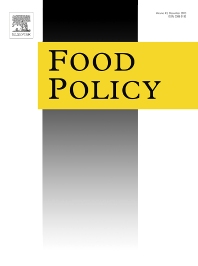Last updated on April 5, 2015
I began a three-year term as associate editor over at Food Policy at the end of 2013, which means that I handle submissions in my areas of expertise, deciding which manuscripts get reviewed and which ones get desk rejected, selecting reviewers for those manuscripts that do get reviewed, and so on.
Once again, I wanted to feature a few articles from the latest issue of the journal. There is nothing special about those articles beyond the fact that I thought they would be of interest to readers of this blog.
On the Political Economy of Guest Worker Programs in Agriculture, by Brad Rickard.
Highlights:
- There is much political debate concerning the use of guest worker programs.
- Labor comprises a large share of total production costs in horticulture industries.
- Competing interests exist for political attention across agricultural industries.
- Horticultural industries receive a disproportional share of benefits from guest worker programs.
- Grain industries may experience small negative impacts from an increase in labor supply.
Supermarkets and food consumption patterns: The case of small towns in Kenya, by Ramona Rischke et al.
- We analyse effects of supermarkets in small towns with different supermarket access.
- We causally link the retail revolution with processed food consumption in developing countries.
- Supermarkets increase the consumption of processed at the expense of unprocessed foods.
- Supermarkets increase daily calorie availability, partly because calories are bought cheaper.
- Supermarkets contribute to the nutrition transition.
Agricultural marketing by smallholders in Kenya: A comparison of maize, kale and dairy, by John Olwande et al.
-
Smallholder participation in maize, kale and milk markets in Kenya is compared.
-
Market access improved overtime but production remains largely subsistence.
-
There is greater market orientation and less market concentration in kale and milk.
-
Land, assets, technology, prices and rainfall are important to market participation.
-
Increasing production is critical to broad-based smallholder market participation.
What dimensions of women’s empowerment in agriculture matter for nutrition in Ghana?, by Hazel Jean L. Malapit and Agnes Quisumbing.
-
Examines empowerment–nutrition links using a new survey-based empowerment measure.
-
Empowerment is more strongly associated with diet quality than nutrition status.
-
Credit decisionmaking is associated with better outcomes for both women and girls.
-
Different domains of empowerment may have different impacts on nutrition.
Enhancing food security of low-income consumers: An investigation of financial incentives for use at farmers markets, by Carolyn Dimitri et al.
- Federal nutrition policy in the US targets the diet of low-income consumers.
- Weekly matching vouchers, used at farmers markets, augment nutrition benefits.
- We model the impact on vegetable consumption of incentives for 300 women.
- Those visiting food pantries are more likely to stop shopping at the market.
- Low education and low produce consumption best predictors of increased consumption.
